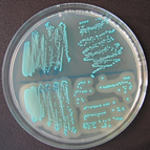You are here:
Listerien

Listerias are widely spread at farms. There are different species: species L. monocytogenes, L. ivanovii, L. seeligeri, L. innocua, L. welshimeri and L. grayi; not all of the mentioned species cause diseases. The disease is called listeriosis.
A large part of the listeriosis diseases in both humans and animals is attributable to infections with L. monocytogenes. In a few cases diseases in humans caused by L. ivanovii and L. seeligeri were reported. In animals and in particular in small ruminants the share of infections with L. ivanovii is higher.
Clinical picture of listeriosis
With several hundred patients per year, listeriosis is one of the more rare food infections in humans. The infection involves for those concerned, however, comparatively serious damage to health. The infection dose depends strongly on the health condition of the person concerned and there is also a strong variation in terms of symptoms. They range from light, flu-like diseases in healthy adults through systemic infections up to meningitis and encephalitis with a high share of fatalities in humans with immuno-compromised conditions. Infections in pregnant women can result in miscarriage and premature delivery. New-borns are often born with serious damage.
Sources of infection
Infection of humans by L. monocytogenes occurs primarily through the consumption of contaminated foods of animal and plant origin but is, as a matter of principle, also possible via direct contact with infected animals or humans. As far as foods involving a risk are concerned, smoked fish, raw milk and raw milk products, cheese, cold cuts, raw sausage and raw minced meat are often mentioned.
Foods of animal origin such as raw milk or raw meat can therefore be contaminated already during milking or slaughtering, vegetables and salad can be contaminated by organic fertilisation (dung, liquid manure). Very often L. monocytogenes is transferred to foods during processing due to poor hygiene. Consequently, mainly so-called ready to eat foods which were no longer subject to a germ killing treatment (eg heat treatment) after processing represent a potential risk.
Characteristics
Listerias are gram-positive, rod-shaped, facultatively anaerobic, non sporogenous bacteria of the Listeriaceae family. They have a length of 1 - 2 µm and a diameter of 0.4 – 0.5 µm. They are peritrichously flagellated and mobile at 20 - 25°C. On sheep blood agar and other non-selective nutrients Listerias grow in round, smooth marginated, flat, whitish to greyish colonies. Optimum growth conditions are found by Listerias at temperatures of 30 – 39°C and a neutral to slightly alkaline pH value. They are, however, extremely tolerant to high temperature and pH variations and can also multiply at temperatures between -2°C and 45°C (including refrigerator temperatures!) and survive at pH 4.5 and 9. Furthermore, Listerias are relatively resistant to high salt concentrations of up to 10%. Given their extremely good adaptability to the surrounding conditions, Listerias occur throughout the world in particular in soil, surface waters, waste water, on plants and in the digestive tract of animals.
Opinion
(3)| Date | Title | Size |
|---|---|---|
|
02.02.2021 BfR Opinion No 004/2021
|
Cases of listeriosis are becoming more common - are ready-to-eat foods to blame? |
865.3 KB
|
|
21.04.2020 BfR opinion No 021/2020
|
Reclaimed waste water: preventing bacterial pathogens on fresh fruit and vegetables |
774.0 KB
|
|
03.06.2013 Updated BfR Opinion No. 011/2013
|
Baseline study on the prevalence of Listeria monocytogenes in specific ready-to-eat foods |
26.0 KB
|
